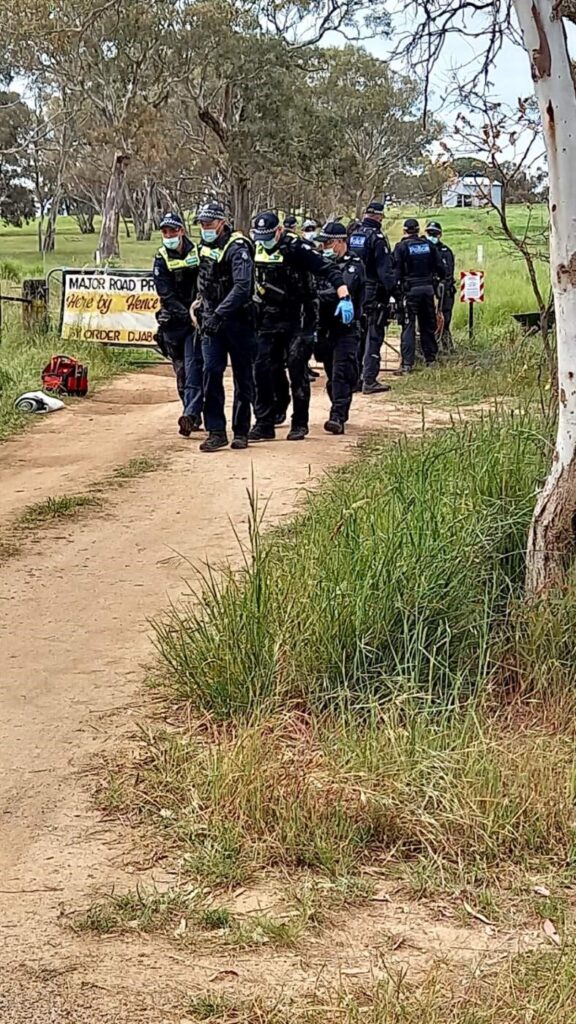November 4th, 2020Chainsaws v. trees: the Buangor battle continues
World news was made last week when a much-valued tree was felled as part of a $157 million widening of the highway, with more than 50 protestors arrested by police.
Part of the disputed land is owned by sisters MairiAnne and Iona Mackenzie, whose family also have the Wombat Park historic house and gardens at the entrance to Daylesford from Castlemaine.
A Supreme Court order has stopped any more tree destruction for three weeks when a case to have the road follow a less damaging and, it is claimed, less expensive route will be heard. Another Supreme Court case is also running and there is a third in the Federal Court.
Protestors say one demonstrator suffered a broken arm in a locked device as $5000 fines were imposed under COVID laws.
Away from the courts the stand-off has become political with Premier Daniel Andrews receiving about 27,000 angry messages. And a move is under way for a Federal Parliamentary Committee, including indigenous MPs and the Greens, to examine laws from 1984 covering matters like this. Fourteen years ago jurist Dr Elizabeth Evatt reported on the need to reform these laws.

Police moved to clear an Aboriginal protest camp between Buangor and Ararat the day before the Premier announced Victoria was emerging from its COVID lockdown, a move that is seen to have backfired because of the resulting outcry.
MairiAnne Mackenzie told The Local: “The police went in before fencing was up, before their mobile chemical toilets arrived, before their security lights which blare all night, and this magnificent tree was chain-sawed. I live there and could hardly find out what was happening with roads blocked and a media blackout.
“The road authority, MRPV, keep saying it saved 16 trees, but the realignment saved only one tree from being killed, a twin-trunk hollow tree, which will still be desecrated with a freeway bridge towering over it.
“Another ‘saved’ tree, the 800 year-old hollow tree, is still very likely to die from the planned root damage, because there hasn’t been any effective realignment around it. Ten more ‘saved’ trees were never threatened, not even in the works area. Four more were only ever going to be trimmed.”
The Auditor-General has been asked to examine a staggering $30 million paid to a contractor when no work was done between July 2018 and January last year. A similar amount is believed to have been paid for the next six months.
Djab Wurrung leaders Aunty Sandra Onus and Marjorie Thorpe launched the latest case over the culturally significant land.
Former judge Ron Merkel QC told last week’s hearing:
“The battle goes to the heart of cultural heritage.
“It appears the defendants are approaching this not in the context of Aboriginal cultural heritage…but as if this is just an object like a museum object,” he said. “We say that is a total renunciation of Aboriginal cultural heritage.
“Djab Wurrung people [have been] excluded from their own country.”
Merkel was opposed by a QC representing the Victorian Government, MRPV, the Secretary of the Department of Transport and the Minister for Transport and Infrastructure. Merkel’s argument is largely that a 2013 Cultural Heritage Management Plan for the project has not been developed and is also out of date.
Merkel said a report by the Victorian Ombudsman highlighted a potential conflict of interest with Martang, the Registered Aboriginal Party, when it gave cultural heritage approval. While Martang rejects the value of the destroyed tree, an archeaological survey paid for by MRPV in December 2018 found that it was a directions or marker tree, noted by traditional owners because of its small round scar and a quartz blade fragment found nearby. This was among 10 Aboriginal sites found outside two areas centred around a pair of culturally modified trees.
In August this year, and after a seven month delay because of staff cuts, Federal Environment Minister Sussan Ley rejected an application for further protection of six trees for a second time. She now wants the states to take over such issues.
About 480 academics from across Australia, including historians, geographers, lawyers and scientists, condemned the loss of the directions tree and urged the government to stop works and protect the remaining trees.
Words: Kevin Childs | Image: Contributed










